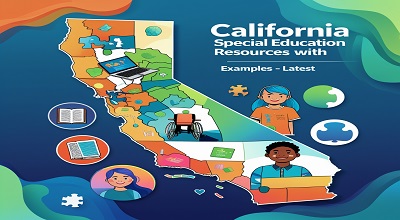California Special Education Resources
California Special Education Resources: In here, Special education in California is designed to provide tailored support for students with disabilities, ensuring they receive a free and appropriate public education (FAPE). The California serves over 800,000 students with disabilities, making it one of the largest special education systems in the U.S.
Key Principles of Special Education in California
- Equity & Access: Ensuring all students receive appropriate educational opportunities.
- Individualization: Customized learning plans (IEPs) based on student needs.
- Collaboration: Involving parents, teachers, and specialists in decision-making.
Examples of Disabilities Served
- Autism Spectrum Disorder (ASD)
- Learning Disabilities (Dyslexia, Dyscalculia)
- Speech and Language Impairments
- Emotional Disturbance
- Intellectual Disabilities
Legal Framework for Special Education in California
California adheres to federal laws like the Individuals with Disabilities Education Act (IDEA) and state-specific regulations.
Key Laws & Policies
- IDEA (Individuals with Disabilities Education Act)
- Guarantees FAPE for students with disabilities.
- Requires IEPs for eligible students.
- California Education Code (Section 56000)
- Defines eligibility criteria for special education services.
- Americans with Disabilities Act (ADA)
- Ensures accessibility in schools and programs.
Example: Compliance in Schools
- Los Angeles Unified School District (LAUSD) provides IEP meetings with parents, specialists, and teachers to ensure legal compliance.
California Special Education Programs and Services
California offers various programs to support students with disabilities.
1. Early Start Program (Ages 0-3)
- Provides early intervention for infants and toddlers with developmental delays.
- Example: Regional centers like East Bay Regional Center offer speech therapy and family support.
2. Special Day Classes (SDC)
- Small-group instruction for students with moderate to severe disabilities.
- Example: San Diego Unified offers SDCs for students with Autism.
3. Resource Specialist Program (RSP)
- Pull-out services for students needing part-time support.
- Example: Santa Clara Unified’s RSP helps students with dyslexia.
4. Non-Public Schools (NPS) & Agencies
- For students requiring highly specialized education.
- Example: Stanbridge Academy serves students with learning differences.
Assessment and Individualized Education Programs (IEPs)
An IEP is a legal document outlining a student’s learning goals and services.
IEP Process in California
- Referral & Assessment
- School psychologists conduct evaluations.
- IEP Meeting
- Parents, teachers, and specialists collaborate.
- Implementation & Review
- Progress is monitored annually.
Example of an IEP Goal
- “By the end of the year, the student will improve reading fluency from 50 to 80 words per minute with 80% accuracy.”
Inclusive Education and Least Restrictive Environment (LRE)
California promotes inclusion, ensuring students learn in general education classrooms when possible.
Examples of Inclusion Strategies
- Co-Teaching: A special education teacher supports in a general ed class.
- Universal Design for Learning (UDL): Adapting lessons for diverse learners.
Parent and Family Resources
Parents play a crucial role in special education.
Key Resources
- California Department of Education (CDE) – Special Education Division
- Family Resource Centers (FRCs)
- Disability Rights California (DRC)
Example: Parent Training
- Support for Families of Children with Disabilities (SFCD) offers workshops on IEP advocacy.
Technology and Assistive Tools for Special Education
Innovative tools enhance learning for students with disabilities.
Examples of Assistive Technology
- Text-to-Speech Software (e.g., Kurzweil 3000)
- Augmentative and Alternative Communication (AAC) Devices
- Adaptive Keyboards & Switches
Professional Development for Special Educators
California invests in teacher training through:
- California Collaborative for Educational Excellence (CCEE)
- Autism Training & Research Centers
Challenges and Future Trends in California Special Education
Current Challenges
- Teacher shortages
- Funding disparities
Future Trends
- Increased use of AI in special education
- Expanded mental health support
Conclusion
California’s special education system is comprehensive but faces challenges. Continued advocacy, funding, and innovation are key to improving outcomes.
FAQs
1. What is the most common disability served in California special education?
Learning disabilities, particularly dyslexia, are the most common.
2. How do I request an IEP evaluation in California?
Submit a written request to your child’s school district.
3. Are charter schools required to provide special education services?
Yes, charter schools must comply with IDEA and provide FAPE.
4. What if I disagree with my child’s IEP?
You can request mediation or a due process hearing.
5. What assistive technology is available for nonverbal students?
AAC devices like Proloquo2Go help nonverbal students communicate.
Free Download Link: Royal x Casino
